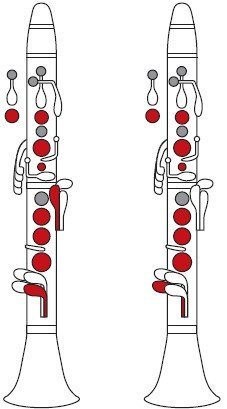The C Whole-Half Diminished Scale has a fascinating history in clarinet music. To appreciate its impact, let's explore its origins and how it has influenced the sounds we hear today.

Clarinet Fingering Charts are always FREE at MartinFreres.net!
What is the C Whole-Half Diminished Scale?
This unique scale, composed of alternating whole and half steps, produces a sound that's both haunting and captivating. Many musicians see it as a doorway to exploring the clarinet's wide-ranging capabilities. The scale includes the notes: C, D, E?, E, F?, G, A, and B, creating a sequence rich in tension and resolution.
| Note | Interval |
|---|---|
| C to D | Whole step |
| D to E? | Half step |
| E? to E | Half step |
| E to F? | Whole step |
| F? to G | Half step |
| G to A | Whole step |
| A to B | Whole step |
| B to C | Half step |
Historical Context
In the late 19th and early 20th centuries, as composers started blending different musical styles, the C Whole-Half Diminished Scale became popular in clarinet music. This era saw musicians exploring fresh sounds and textures, driven by the rise of jazz and avant-garde music. Famous clarinetists like Benny Goodman and Artie Shaw embraced this scale, making it a key tool for improvisation and artistic expression.
Jazz Influence
Jazz players found the C Whole-Half Diminished Scale particularly useful for breaking away from typical melodic lines and rhythmic patterns. Imagine being able to create various moods and tones in your playing, all from one scale! It's like having a special set of musical paints to express emotions, easily shifting from melancholy to joy.
Impact on Classical Music
The scale's influence extended beyond jazz into classical music. Composers such as Igor Stravinsky and Arnold Schoenberg incorporated it into their works. Stravinsky, for example, combined it with traditional forms, creating pieces that balanced old conventions with new ideas. It's amazing to consider how one scale can bridge such different musical worlds!
Technique and Teaching
The C Whole-Half Diminished Scale is also important for clarinet technique and teaching. Learning this scale can improve a clarinetist's ability to improvise and their overall musical skills. It encourages players to be creative with phrasing, articulation, and volume control. Plus, it's an exciting scale to add to practice sessions for some variety!
The Role of Quality Instruments
The influence of respected brands like Martin Freres can't be overlooked. They're known for making excellent instruments that can produce a wide range of sounds, perfect for playing the intricate C Whole-Half Diminished Scale. Selecting a clarinet is a personal decision that can significantly impact how a musician works with this scale and creates music.
Looking to the Future
As we listen to and learn from today's clarinetists, it's exciting to think about how the C Whole-Half Diminished Scale will continue to evolve. It's deeply connected to clarinet music, and its rich history inspires both new and experienced musicians to explore this remarkable scale.
Next time you play your clarinet, why not try out the C Whole-Half Diminished Scale? It might lead you on an unexpected musical adventure that showcases the beauty and versatility of this amazing instrument!







